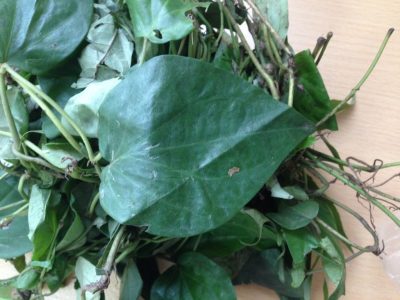Iteji is a common plant that grows in Nigeria. It is mainly used to prepare soups because of its ability to improve the taste and aroma of the food. Iteji has many important nutrients and vital compounds which possess medicinal properties. The health benefits of Iteji include, malaria treatment, pain relief, diabetes treatment, cough treatment, and liver and kidney protection etc.
The plant is very abundant in West Africa. In Nigeria, the plant holds a special place in the hearts of many. The common names of Gongronema latifolium are utazi in Igbo, Utasi” by the Ibibios,
Quas and Efiks, Arọ́kẹ́kẹ́ in Yoruba, Iteji by Ikales of Ondo State, Ndodo-Polole by Kissis of Sierra Leone, Gasub by Serers of Senegal, “Akan-Asante aborode” in Ghana, etc.
In Sierra Leone, they use the stem as chewing stick, while the leaves are used as vegetable to add taste to soup, or in spicing local beer. The leaves of Gongronema latifolium is a possible substitute for hops in the production of beer. Iteji leaf extract has antibacterial property and low bittering values, compared to hops.
The leaves are used as vegetable in soups, or can be dried to powder to serve as spices. Iteji leaves can be used for so many things, including food preparation and herbs. This article discusses the huge health benefits below:
Pain Relief
Iteji is also used to relieve pains in parts of the body. For example, rubbing Iteji leaves on cuts and bruises can help to significantly reduce the pain from the injury as well as stop the bleeding, if any. It is also used to treat and manage internal pain, like pain in the muscles and joints. The liquor obtained from the plant is also used traditionally to treat colic, and worms.
Improve Digestion
Eating Iteji also helps one to maintain a healthy eating habit by making it easier to digest food without running into problems like constipation or stomach ache. Iteji is effective in treating said conditions. It helps to normalize metabolism and increase one’s appetite.
Malaria Treatment
Before the introduction of pills and drugs, Iteji has been used in treating malaria. In Ikale, the leaves would be blended with a little taken, (a tea spoon) and mixed with a liter of fresh palm wine. It has been proven by the Ikale speaking tribe of Ondo State as very effective and potent in flushing out malaria. It can also be used alone or mixed with other plants to create a potent herb that would remove malaria from the body and help restore good health. Some studies have found out that Iteji leaves have antiplasmodial properties.
Treatment of Cough/asthmatic symptoms
Iteji was also very helpful in treating cough and cough-like symptoms. The leaves were cheered, or the juice was directly extracted from the leaves, and once it was taken, the cough would subside to an extent. It is also used to manage asthma and eliminate or reduce asthmatic symptoms.
Cholesterol and Blood Sugar
Taking Iteji also helps to keep one’s cholesterol levels in check and also reduces blood sugar levels. Iteji has been shown to reduce glucose in the blood, helping people with diabetes manage their condition better. By reducing bad cholesterol levels, Iteji helps to keep your heart healthy and free of disease.
Post Pregnancy Treatment
Iteji is taking by nursing mothers to counter the effect of pregnancy, like to reduce the size of the stomach following delivery, to clean the uterus, and also to help with weight loss. It is used to restore the body after the period of pregnancy.
Antioxidant property:
This plant contains flavonoids that mop up free radicals which can cause diseases like cancer, diabetes, neurodegenerative diseases, and cardiovascular diseases. The extract increased the activity of antioxidant enzymes such as peroxide dismutase, glutathione reductase, glutathione peroxidase, and decreased levels of plasma MDA, a significant marker for lipid peroxidation.
Anti-ulcer property:
The extract may increase mucus production, and reduce ulcer sores. It also decreases chemical induced stomach injury. Saponins present have anti-ulcer property.
Antimicrobial activity:
The methanolic leaf extracts of Gongronema latifolium inhibit microorganisms such as Staphylococcus aureus, Salmonella enteritidis, Salmonella typhimurium, Salmonella cholerasius, Pseudomonas aeruginosa, Listeria monocytogenes, and leishmaniasis causing organism, Leishmania chagasi.
The aqueous leaf extracts inhibited Staphylococcus aureus, Escherichia coli, and Pseudomonas aeruginosa
Restores electrolyte balance:
Ethanol leaf extract of the plant increases level of sodium, calcium, sodium, zinc, and bicarbonate, restoring blood electrolyte levels.
Anti-diabetic effect:
Lab experiment with leaves, root, and stem extract of Gongronema latifoliumn suggests it has a dose-dependent reduction on glucose concentration in alloxan induced diabetic
rats. G. latifolium also modulates glucose homeostasis.
Hypolipidemic effects:
Results from tests with the ethanolic root extract of the plant in streptozotocin induced diabetic rats showed a significant reduction in total cholesterol, serum glucose, triacylglycerol, and low density lipoprotein. On the other hand, it increased high density lipoprotein.
Kidney protection:
Leaf extract of utazi may reduce the levels of urea and creatinine, important markers for kidney damage and dysfunction.
Protective effect on the liver:
In laboratory test with albino rats induced with hepatic toxicity using acetaminophen, the extract of the leaf decreased malondialdehyde (MDA), and serum liver enzymes such as alanine transaminase, aspartate transaminase, and alanine phosphatase.
These enzymes cause oxidative stress and liver damage.
Male fertility:
Extracts of both Ocimum gratissimum and Gongronema latifolium may decrease sperm motility, sperm count and sperm viability.
Anti-cancer effect:
Studies suggest that utazi leaf extract has strong inhibitory action against human lung carcinoma and human breast adenocarcinoma.
Inflammation:
The leaf extracts inhibited carrageenan induced rat paw oedema, carrageenan induced leukocyte migration in mice, and nystatin-induced rat paw oedema in laboratory test results.
Gastric emptying:
The extract may cause delay in gastric emptying, which may cause reduction in postprandial blood glucose.
Immunomodulation:
The leaf extracts may have immune stimulatory effect, and may be useful in treating conditions caused by immune dysfunction.
Hematological effect:
In a lab test with diabetes induced rat, the extract caused a decrease in the level of CD4+ cell count, platelets, monocyte, white blood cells, and neutrophils. There is also a significant increase in RBC count, hemoglobin, lymphocyte, eosinophil, PCV, MCH and MCHC.
Nutritional Composition of Gongronema latifolium (Iteji)
Gongronema latifolium, (Iteji) or utazi contains a lot of nutrients, fats, minerals, amino acids, and vitamins. The leaves have high amino acid content. It can be eaten fresh, or dried. The protein content is high, 27.2%, and comparable with cow pea, fluted pumpkin leaves, Hibiscus esculentus, Tamarindus
indica.
Gongronema latifolium contains crude fat, 6.7% that is comparable to other leafy vegetables. The fat is good for energy, and contains linoleic acids, an essential fatty acid that regulates most body functions like blood pressure, gastric secretion.
There are also high content of vitamins such as vitamin A (carotene), C (ascorbic acid), E (tocopherol), and some quantities of vitamin B1 (thiamine), B2 (riboflavin), and B3 (niacin). Vitamin A is good for vision and prevention of night blindness. Vitamin C and E contains enough quantity of antioxidants that prevent oxidative damage and heart diseases.
The main mineral contents are sodium, potassium, calcium, copper, iron, zinc, magnesium, phosphorus, lead, and cobalt.
Amino acids present are both essential amino acids such as theonine, valine, isoleucine, leucine, lysine, tyrosine, methionine, phenylalanine, and non-essential amino acids such as alanine, arginine, aspartic acid, glycine, glutamic acid, glycerine, histidine, valine. They help in protein synthesis, and serve as metabolic intermediates.
Bioactive Constituents of Gongronema latifolium
Gongronema latifolium, or utazi contains bioactive elements that have health benefits such as 17β-marsdenin derivatives (pregnane glycosides). The leaves also contain saponins, flavonoids, resins, steroids, cardiac glycosides, alkaloids, phytate, anthranoids, anthraquinone, tannins, polyphenols, phblobatannins, phytosterols, terpenes, anthocyanidins, β-sistosterol, lupenyl esters, lupenyl cinnamate, hydroxymethyl anthraquinones, reducing compounds, essential oils, cyanogenic glycosides among others.
Essential oils from the Gongronema latifolium leaves containst inalool (19.5%), (E)-phytol (15.3%) and aromadendrene hydrate (9.8%).
The fruit contains alkaloids, flavonoids, hydrocyanic acid, phenols, phytic acid, saponins, tannins, while the stem contains alkaloids, flavonoids, hydrogen cyanide, saponins, tannins.
Credit & References: Pharmchoices, and Healthguide Websites.










Leave a Reply